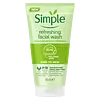What's inside
What's inside
 Key Ingredients
Key Ingredients

 Benefits
Benefits

 Concerns
Concerns

 Ingredients Side-by-side
Ingredients Side-by-side

Water
Skin ConditioningGlycerin
HumectantSodium Cocoyl Glycinate
CleansingMyristic Acid
CleansingMontmorillonite
AbsorbentButylene Glycol
HumectantPalmitic Acid
EmollientGlycol Stearate
EmollientLauric Acid
CleansingStearic Acid
CleansingCI 77891
Cosmetic ColorantPotassium Hydroxide
BufferingParfum
MaskingButyrospermum Parkii Butter
Skin ConditioningPhenoxyethanol
PreservativeSodium Hydroxide
BufferingSodium Hexametaphosphate
MaskingButylparaben
MaskingSalicylic Acid
MaskingTetrasodium EDTA
Propylparaben
PreservativeP-Anisic Acid
MaskingO-Cymen-5-Ol
AntimicrobialRosa Canina Fruit Oil
EmollientHexyl Cinnamal
PerfumingTocopherol
AntioxidantPropylene Glycol
HumectantAlpha-Isomethyl Ionone
PerfumingGeraniol
PerfumingFarnesol
PerfumingRosa Gallica Flower Extract
AstringentCI 17200
Cosmetic ColorantNelumbium Speciosum Flower Extract
Skin ConditioningCI 14700
Cosmetic ColorantWater, Glycerin, Sodium Cocoyl Glycinate, Myristic Acid, Montmorillonite, Butylene Glycol, Palmitic Acid, Glycol Stearate, Lauric Acid, Stearic Acid, CI 77891, Potassium Hydroxide, Parfum, Butyrospermum Parkii Butter, Phenoxyethanol, Sodium Hydroxide, Sodium Hexametaphosphate, Butylparaben, Salicylic Acid, Tetrasodium EDTA, Propylparaben, P-Anisic Acid, O-Cymen-5-Ol, Rosa Canina Fruit Oil, Hexyl Cinnamal, Tocopherol, Propylene Glycol, Alpha-Isomethyl Ionone, Geraniol, Farnesol, Rosa Gallica Flower Extract, CI 17200, Nelumbium Speciosum Flower Extract, CI 14700
 Reviews
Reviews

Ingredients Explained
These ingredients are found in both products.
Ingredients higher up in an ingredient list are typically present in a larger amount.
Glycerin is already naturally found in your skin. It helps moisturize and protect your skin.
A study from 2016 found glycerin to be more effective as a humectant than AHAs and hyaluronic acid.
As a humectant, it helps the skin stay hydrated by pulling moisture to your skin. The low molecular weight of glycerin allows it to pull moisture into the deeper layers of your skin.
Hydrated skin improves your skin barrier; Your skin barrier helps protect against irritants and bacteria.
Glycerin has also been found to have antimicrobial and antiviral properties. Due to these properties, glycerin is often used in wound and burn treatments.
In cosmetics, glycerin is usually derived from plants such as soybean or palm. However, it can also be sourced from animals, such as tallow or animal fat.
This ingredient is organic, colorless, odorless, and non-toxic.
Glycerin is the name for this ingredient in American English. British English uses Glycerol/Glycerine.
Learn more about GlycerinPhenoxyethanol is a preservative that has germicide, antimicrobial, and aromatic properties. Studies show that phenoxyethanol can prevent microbial growth. By itself, it has a scent that is similar to that of a rose.
It's often used in formulations along with Caprylyl Glycol to preserve the shelf life of products.
Propylene Glycol is an odorless, colorless liquid. As a humectant, it helps skin retain moisture. It also aids in delivering active ingredients.
Another role of this ingredient is preventing a product from melting or freezing. Propylene glycol also adds antimicrobrial properties to a product, elongating product lifespan.
This ingredient is considered an organic alcohol and commonly added into both cosmetics and foods.
Those with sensitive skin or conditions may develop a rash when using this ingredient.
Learn more about Propylene GlycolSodium Hydroxide is also known as lye or caustic soda. It is used to adjust the pH of products; many ingredients require a specific pH to be effective.
In small amounts, sodium hydroxide is considered safe to use. However, large amounts may cause chemical burns due to its high alkaline.
Your skin has a natural pH and acid mantle. This acid mantle helps prevent harmful bacteria from breaking through. The acid mantle also helps keep your skin hydrated.
"Alkaline" refers to a high pH level. A low pH level would be considered acidic.
Learn more about Sodium HydroxideWater. It's the most common cosmetic ingredient of all. You'll usually see it at the top of ingredient lists, meaning that it makes up the largest part of the product.
So why is it so popular? Water most often acts as a solvent - this means that it helps dissolve other ingredients into the formulation.
You'll also recognize water as that liquid we all need to stay alive. If you see this, drink a glass of water. Stay hydrated!
Learn more about Water